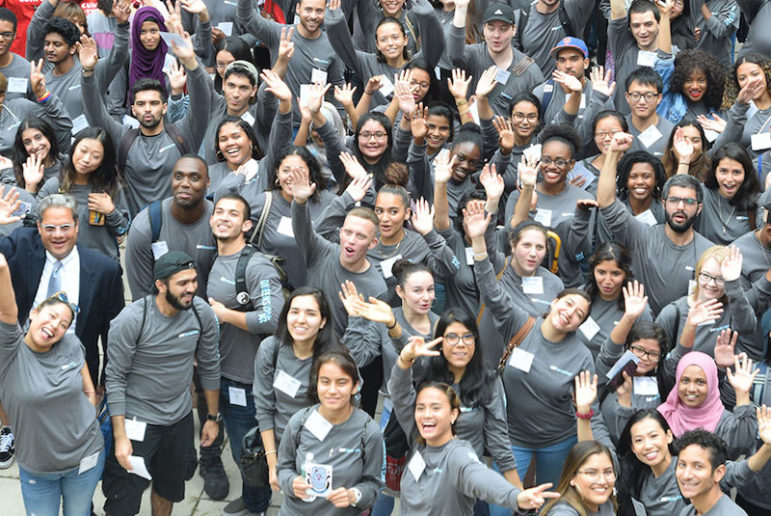‘While I and many other CUNY employees are enraged at the chancellor’s handling of the crisis, he is also administering a system that was slashed in 1975 and gradually bled almost every year since.’

CUNY
CUNY’s 25 institutions, including 11 senior colleges and seven community colleges, serve more than 275,000 students annually.The City University of New York is in jeopardy. As thousands of students return to CUNY this fall, they will face rising online class sizes, scarce career and mental-health resources and crumbling infrastructure – threatening the quality public education they need and deserve.
On June 30th, the CUNY administration, under the leadership of Chancellor Félix Matos Rodríguez laid off some 3,000 adjunct faculty in a pitiful attempt to balance his budget. He “saved” a tiny fraction of the multi-billion-dollar cost of educating half a million students each year—but the cost both to students and those faculty who remain on payroll is ballooning online class sizes.
Research on distance learning suggests that we should be doing precisely the opposite in the online environment: shrinking class size to keep students engaged and connected to their professors. But at Kingsborough Community College, where the previous cap for online classes was 25, this fall it is 29—precisely the wrong direction. At Queens College class caps are increasing 20 percent. At Medgar Evers College, the cap for online courses is 42 students!
The chancellor projected to the city and then finally executed a decreased quality of education when he could have supported CUNY students by fighting for more. But while I and many other CUNY employees are enraged at the chancellor’s handling of the crisis, he is also administering a system that was slashed in 1975 and gradually bled almost every year since.
At the same time that the chancellor could have made different and better decisions, he is also being forced to cut from a budget that is already at the bone. If CUNY were funded at the per- student rate of just the 1990s—forget the 1970s—the budget would be a full billion dollars larger.
Our classes are too full and getting fuller; our students lack the career and mental health services they need; and our buildings are crumbling, literally.
 CityViews are readers’ opinions, not those of City Limits. Add your voice today!
CityViews are readers’ opinions, not those of City Limits. Add your voice today!
But all of this could be fixed. It could have been fixed a decade ago, and, notwithstanding the crisis, it can be fixed today. While the federal government has abdicated responsibility in the COVID crisis, New York is in a relatively unique position: We have a tax base that enables us to create the sorts of broad, social democratic legislation that one would expect of a federal government.
New York Senator Rachel May and Assemblymember Aravella Simotas are sponsoring a bill that would create new high-income tax brackets and, at the top bracket—those with more than $100,000,000 in taxable income—raise the state income tax rate to 10.32 percent.
Let’s just pause for a minute on the fact that there are New Yorkers who have $100,000,000 in taxable income. Meanwhile, 3,000 CUNY instructors are laid off in the middle of a pandemic, hundreds of whom lost their health insurance, the effect of which was to increase class sizes at precisely the moment we should be decreasing them. If you think that the richest New Yorkers can afford a measly 10.32 percent tax rate on their income over one hundred million dollars, you are not in the minority. In fact, recent polling conducted by the Communications Workers of America shows that not only do New Yorkers—both Democrats and Republicans—support raising taxes on billionaires, but a supermajority support raising taxes on those with more than $500,000 in annual income.
The Mayer/Simotas bill is one of a bundle that the movement to Make Billionaires Pay is pressing the legislature to pass in this moment of health and economic crisis. Right here in New York, we have the ability to fund CUNY fully—reverse these layoffs, yes, but also make new hires to ensure that CUNY students have the class sizes they need in a COVID-inflected distance learning environment.
But we can do even more. The movement to Make Billionaires Pay is fighting not just for CUNY but for all public services; not just for essential workers but for all workers. Not a dime needs to be cut from the current fiscal operating budget that the legislature approved in April. In fact, we can do the opposite—in a moment when the likes of Jeff Bezos can see his net worth increase by $7.5 billion in a single day, we can imagine—and then execute—taxes that increase our investment in the public services and in the workers who make New York State possible and who make it thrive.
Assembly Speaker Heastie and Senate Leader Stewart-Cousins both see the wisdom in this approach. CUNY professors see it. Your average New Yorker sees it.
What remains to be done is to pass bills like the one carried by Senator Mayer and Assemblymember Simotas, to create a modicum of tax justice in the midst of the worst economic crisis since the 1930s and the worst health crisis since the 1910s.
The legislature must ensure that New York’s public universities have the resources they need, as the founders of the Free Academy of the City of New York said in 1847, “to educate the children of the whole people.”
Luke Elliott-Negri is a Professional Staff Congress executive committee university-wide officer and non-teaching adjunct at the CUNY School of Labor and Urban Studies.









One thought on “Opinion: New York’s Billionaires Can Afford to Help Save CUNY”
You should be calling for a wealth tax. Gains in the wealth of people like Bezos are not taxed by instituting higher income taxes unless they sell their holdings–something they are not likely to do. See my article
https://www.counterpunch.org/2020/05/15/simple-solution-to-californias-anticipated-54-billion-budget-deficit/